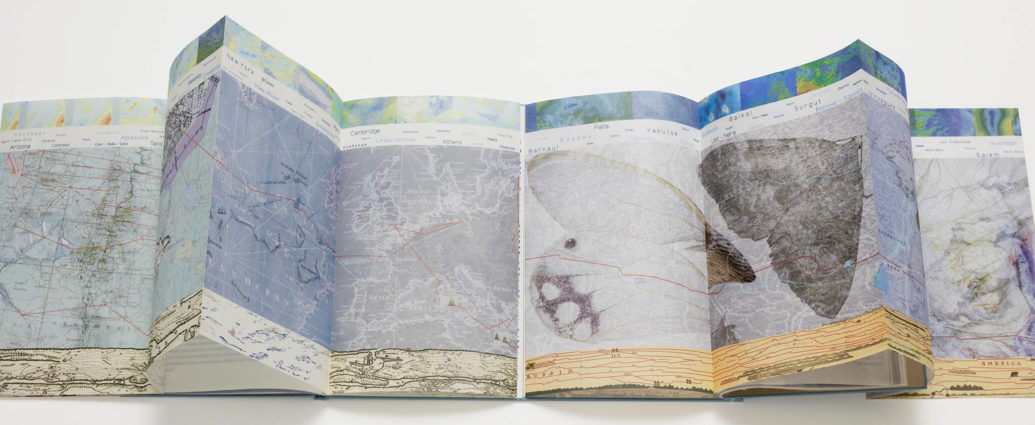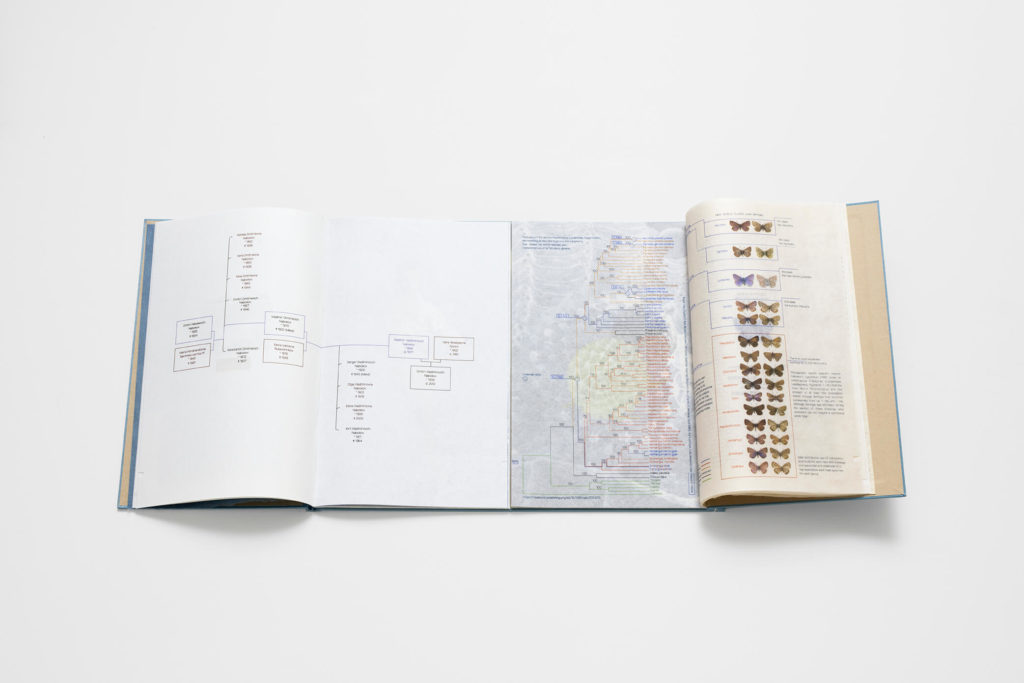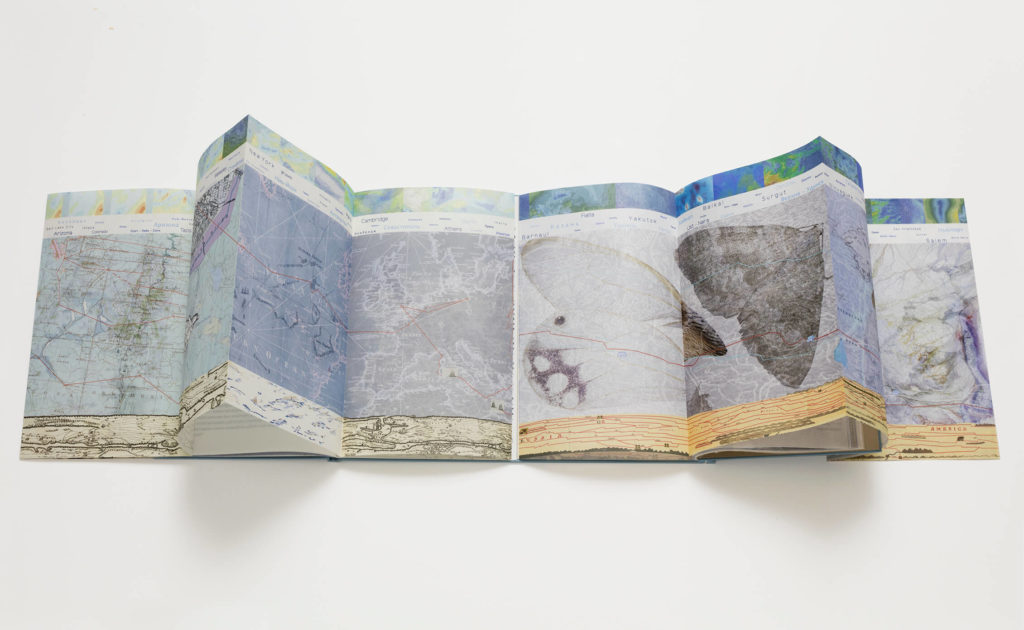FROM EAST TO WEST: VLADIMIR NABOKOV AND HIS BUTTERFLIES CROSS AT BERINGIA
Tatjana Bergelt’s recently published artist’s book «Pas de Deux» (2022) focuses on Vladimir Nabokov’s other passion besides literature, namely the study of butterflies. More precisely, Vladimir Nabokov’s hypothesis that the butterflies «Neotropical Polyommatus blue butterflies» dispersed from Asia to America through Beringia in five colonisation events from ca. eleven until one million years ago. Before finding its way to visual art, this hypothesis by Vladimir Nabokov gained attention in science. In 2011, Roger Vila and the research group under Prof. Naomi Ellen Pierce published an article in “Proceedings of the Royal Society” about their tests of his hypothesis: their results support it. Upon this article, Tatjana Bergelt started «Pas de Deux» in 2018.
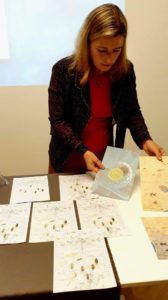
Tatjana Bergelt (*1966) is an artist based in Finland with Russian and German background. She holds two Master of Fine Arts Degrees of Hochschule für Kunst und Design Burg Giebichenstein Halle (1990) and École Nationale Supérieure des Beaux-Arts à Paris (1996). In her artistic practice, she works with photography, drawing, mixed media, collage, artist’s book and litography. In 2023 and 2022, she was an invited speaker at Klingspor Museum Offenbach (DE), Vladimir Nabokov Conference at Lausanne (CH), Bibliophile Society in Finland, Vladimir Nabokov Conference at Wellesley College M.A. (USA) and an attendee at CODEX Foundation (USA). Recent solo exhibitions include Kone Foundation showroom (FI), CODEX Foundation, Wellesley College MA. (USA), Artbook Berlin (DE) and Frankfurt International Book Fair (DE).
Personal interest for Beringia was the starting point why I chose to focus in the interview with Tatjana Bergelt on her work «Pas de Deux». When I was a child, I was dreaming about Beringia many times. For me, Beringia is the shortest connection between East and West and the International Date Line suggests even a temporal bridge. To the north and south open the North Pole and the Pacific Ocean. This unreal character of Beringia attracts me still today. The artist’s book «Pas de Deux» is structured by two separate book bindings to the left and to the right. In the left binding, Tatjana Bergelt focuses on Vladimir Nabokov and in the right binding on his subject of research, the «Neotropical Polyommatus blue butterflies». She includes visual and textual material of various sources, for example quotes and drawings by Vladimir Nabokov, scientific diagrams as well as a scheme of a chess game and a crossword puzzle. The main techniques are photo collage and ink jet printing. In my interpretation, each corresponding double page functions as a poetical metaphor to connect Vladimir Nabokov and these butterflies. Then, the spectator can thumb the two bindings and create his own combinations. For example, at the corresponding position in the left and right binding their respective migrational paths are shown. Departing in opposite directions, they both lead to America. The delicate being of butterflies and its symbol of transformation are a poetic image. Nevertheless, on other pages, the artist’s concept reached its limit when reproduced research elements are left in a «raw» state and therefore offer a rather enumerative experience. At times, the artist includes or excludes spectators who do not speak both languages. Textual elements are in English or Russian, sometimes accompanied by a translated equivalent, sometimes not. Furthermore, when not translated, the languages are also represented asymmetrically: major parts of the artist’s book are exclusively in English and very small parts exclusively in Russian. For all these choices, I could not deduce possible reasons from content or context. A last note: Tatjana Bergelt cites real and fictitious specialists, she names the latter with anagrams of her own name. Explore yourself who of the specialists is real, she works with fiction also when citing specialists. My following questions to the artist Tatjana Bergelt were answered by her in written correspondence (except for the first one).
— Which literary work by Vladimir Nabokov do you appreciate in particular?
For me, Nabokov is like an encyclopedia. It is, as if you asked me, which word I appreciated the most. Well, I started with «Pnin», then I read «Lolita» and now «Pale Fire». When you open yourself for Nabokov, it is comparable to diving into a mountain lake. A boost of ideas overcomes you. It is a world in itself that doesn’t leave you anymore. The way to approach Nabokov should be done from the perspective that is most convenient for you. For example, «Pale Fire» is written in the form of poetry. This doesn’t represent a barrier for somebody who has read Pushkin, but for somebody else it could.
— How did you learn about the scientific article supporting Vladimir Nabokov’s hypothesis?
I was searching something, not memorable on the Internet, and for some inexplicable reason, google spat an article out, which was stating that Nabokov’s hypothesis of the Polyommatus Blue butterflies’ evolution was proven via phylogenetic analysis, and this title was so intriguing since I didn’t know that he had studied the evolution of butterflies. I did know something about phylogenetic analysis so I wanted to know more and that started the avalanche.
— What relation do you have to Vladimir Nabokov’s literature?
I am interested in Nabokov’s worlds. I am still a student of his witt, thoughts, particular and detailed expressions and phantasmic games.
— What was the biggest challenge for you when working on your artist’s book «Pas de Deux»?
One of the biggest challenges was to work with facts, namely the existing writer Vladimir Nabokov and the proven evidence of the Polyommatus butterfly phylogenetic tree, their evolution and still create my own artistic view and space about the parallel passions of the writer in relation to time and the subjects. To absorb the existing knowledge, the forgoing research, at the same time questioning those and, to find the freedom of my personal expression concerning the interaction between these facts – that was difficult.
— What potential do you see in the medium of the artist’s book?
The artists’ book combines artistic expression, language, craftsmanship, different technologies and book art. It is a piece of art in itself, created and produced at all stages by the artist, usually in a small edition or as a unique piece.
The artist’s book is the result of systematic inquiry and artistic creation. It is a small edition or a unique work of art conceived and made by the artist employing the codex of the book. I deliberately use various languages, the rhythm and graphic forms of letters and fonts as a visual element in my work. I juxtapose verbal metaphors with layered imagery, use the code of the book to express continuity, fragmentation but also simultaneity. In addition to narrating techniques, I am using the dialogue between montage and fragmentation, between the underlying thought and the visible. The viewer’s culturally bound linguistic interpretation multiplies, because I combine verbal expressions with my very personal visual language and writing style distortion. The potential of the artists’ book therefore lies in the combination of historical and contemporary techniques as well as the continuity how the codex of a book narrates thought, rhetorically emphasised via translation into haptic experience, all conceptualised by the artist. The artists’ book does not only accumulates history simply by mirroring the historical book codex but contributes through its reflective content to various debates in multiple fields. Its limitation – the required private and intimate space can also be seen as the artists’ books strength, since we live in a rapidly changing, surface and effect orientated environment, in which retreat into an inner world shall provoke the real change.
— What are you working on at the moment?
I aim to create through the investigation of the origins and varies understandings of the term “forgiveness” a readable аne visible narrative in form of an artist’s book. Visualizing and discussing various mutations of this rather broadly and populistically used word will in my opinion, be enriching our understanding of forgiveness. By revealing a fundamental examination of the term forgiveness in an artistic translation we may find solutions to reconcile. The method is based on questioning possible propositions through thinking, exploring the possible origin of the act of forgiveness. During the course of analyses I form a visual structure, related and according languages under examination. I am beginning with the comparison between Ancient Greek, Roman and Judo-Pre Christian understandings in practices of forgiveness. I wish to use Indo-European languages a Uralic language (Finnish, Northern Sámi), Latin and Hebrew, but also want to integrate indigenous languages like Cherokee, an American Indian language. I will use linguistic-historical,-philosophical and – visual approaches to encompass the possible territory of forgiveness. I examine forgiveness as a living organism with its historical “character” and evolution, not on a psychological medical level.
— What inspires you?
I am inspired by innovative thinking expressed in language, (literature) images (photography and film) or movement of the body (contemporary dance). Music makes my mind travel in time and accesses memories.
— What is most important for you in «Pas de Deux»?
For me the utmost importance lied in the interplay of visible and vailed, facts and imagined material, accuracy in detail and abundancy of beauty – something Nabokov would have had joy to discover and de-code.
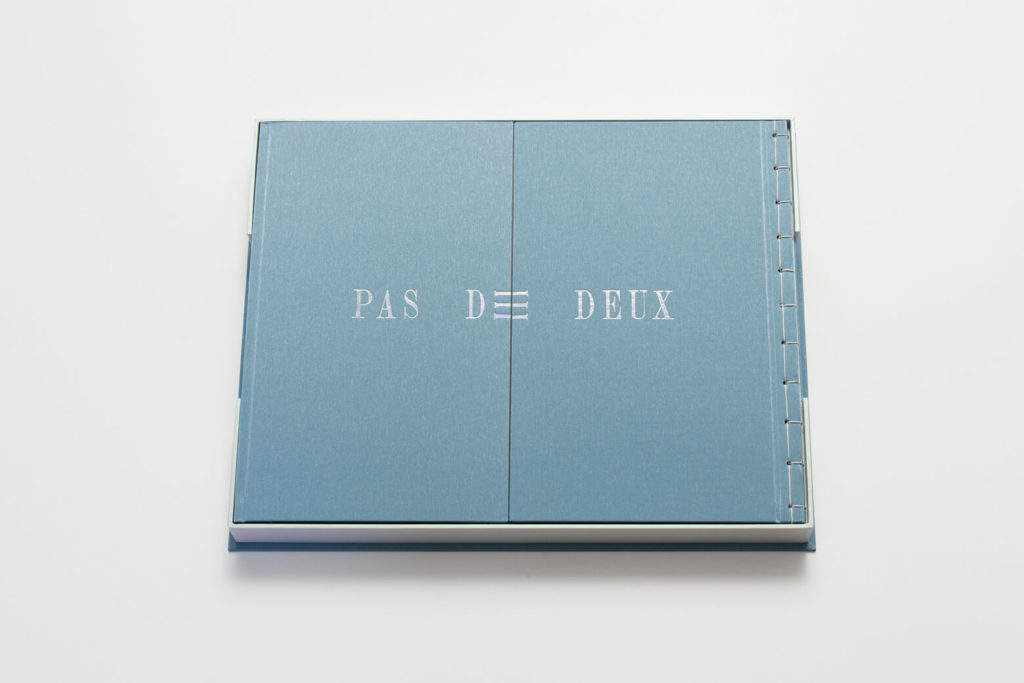
Interview and article by: Emily Мagdalena Orlet, At Malmö Art Academy / Lund University
Illustrations from the book «Pas de Deux» by: © Tatjana Bergelt
Edited by: Juliana Wiemer, University of Konstanz and Olga Burenina-Petrova, University of Zurch & University of Konstanz

